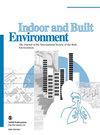The impact of barrier arrangements on the transmission of respiratory infectious diseases in nursing homes in Hong Kong
IF 2.9
3区 工程技术
Q2 CONSTRUCTION & BUILDING TECHNOLOGY
引用次数: 0
Abstract
Respiratory infectious diseases have affected the health of the elderly. This study investigated the optimization of physical barriers as a low-cost design strategy to reduce the risk of infection in nursing homes for the elderly in Hong Kong, which were significantly affected by the outbreak of COVID-19. First, data on two types of rooms, single and multi-occupancy, were collected from a field investigation of typical local nursing homes. Subsequently, Computational Fluid Dynamics (CFD) simulations were employed to analyse the effects of various barrier heights on the propagation, suspension, deposition and elimination of aerosol particles in these room types, thereby evaluating infection risks. The findings reveal that in single-occupancy rooms, a barrier height of 2.1 m is effective in curtailing the spread of the virus over distances. Conversely, in multi-occupancy rooms, while a 1.8-m barrier is necessary, the rate of particle suspension is considerably higher, necessitating additional ventilation measures. Based on these findings, the study provides quantitative criteria for the implementation of physical barriers as a low-cost physical measure in nursing homes and provides recommendations for the effective prevention of respiratory infectious diseases through design modifications.屏障安排对香港疗养院呼吸道传染病传播的影响
呼吸道传染病影响着老年人的健康。本研究探讨了如何优化物理屏障,将其作为一种低成本的设计策略,以降低受 COVID-19 爆发严重影响的香港养老院的感染风险。首先,通过对本地典型疗养院的实地调查,收集了单人和多人两种类型房间的数据。随后,研究人员利用计算流体动力学(CFD)模拟分析了不同阻隔高度对气溶胶粒子在这些房间内的传播、悬浮、沉积和消除的影响,从而评估了感染风险。研究结果表明,在单人房间中,2.1 米的屏障高度可有效遏制病毒的远距离传播。相反,在多人房间中,虽然需要 1.8 米的屏障,但微粒的悬浮率要高得多,因此有必要采取额外的通风措施。基于这些发现,该研究为在养老院实施物理屏障这一低成本物理措施提供了量化标准,并为通过修改设计有效预防呼吸道传染病提供了建议。
本文章由计算机程序翻译,如有差异,请以英文原文为准。
求助全文
约1分钟内获得全文
求助全文
来源期刊

Indoor and Built Environment
环境科学-工程:环境
CiteScore
6.40
自引率
25.00%
发文量
130
审稿时长
2.6 months
期刊介绍:
Indoor and Built Environment publishes reports on any topic pertaining to the quality of the indoor and built environment, and how these might effect the health, performance, efficiency and comfort of persons living or working there. Topics range from urban infrastructure, design of buildings, and materials used to laboratory studies including building airflow simulations and health effects. This journal is a member of the Committee on Publication Ethics (COPE).
 求助内容:
求助内容: 应助结果提醒方式:
应助结果提醒方式:


